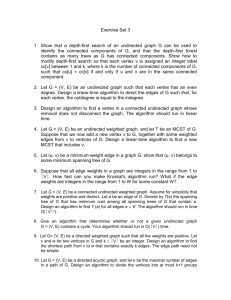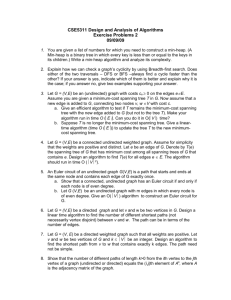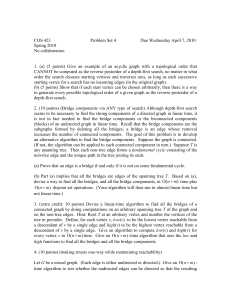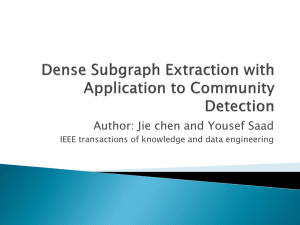Undirected Graph
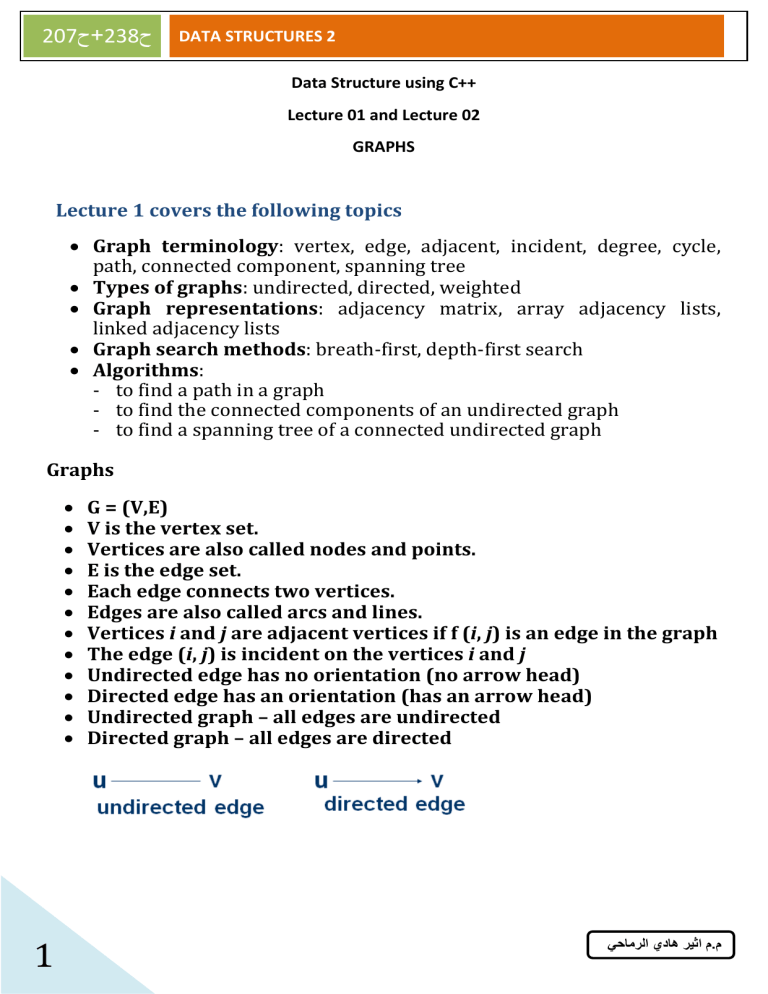
1
207 ح+ 238 ح
DATA STRUCTURES 2
Data Structure using C++
Lecture 01 and Lecture 02
GRAPHS
Lecture 1 covers the following topics
Graph terminology: vertex, edge, adjacent, incident, degree, cycle, path, connected component, spanning tree
Types of graphs: undirected, directed, weighted
Graph representations: adjacency matrix, array adjacency lists, linked adjacency lists
Graph search methods: breath-first, depth-first search
Algorithms:
to find a path in a graph
to find the connected components of an undirected graph
to find a spanning tree of a connected undirected graph
Graphs
G = (V,E)
V is the vertex set.
Vertices are also called nodes and points.
E is the edge set.
Each edge connects two vertices.
Edges are also called arcs and lines.
Vertices i and j are adjacent vertices if f (i, j) is an edge in the graph
The edge (i, j) is incident on the vertices i and j
Undirected edge has no orientation (no arrow head)
Directed edge has an orientation (has an arrow head)
Undirected graph – all edges are undirected
Directed graph – all edges are directed
يحامرلا يداه ريثا م.م
207 ح+ 238 ح
DATA STRUCTURES 2
Undirected Graph
Directed Graph (Digraph)
Directed Graph
It is useful to have a slightly refined notion of adjacency and incidence
Directed edge (i, j) is incident to vertex j and incident from vertex i
Vertex i is adjacent to vertex j, and vertex j is adjacent from vertex i
Applications – Communication Network
2 vertex = router edge = communication link
يحامرلا يداه ريثا م.م
207 ح+ 238 ح
DATA STRUCTURES 2
Applications - Driving Distance/Time Map
Applications - Street Map vertex = city edge weight = driving distance/time
3
• Streets are one- or two-way.
• A single directed edge denotes a one-way street
• A two directed edge denotes a two-way street
Path:
• A sequence of vertices P = i1, i2, …, ik is an i1 to ik path in the graph G=(V, E) if the edge (ij, ij+1) is in E for every j, 1≤ j < k
Simple Path:
A simple path is a path in which all vertices, except possibly in the first and last, are different
Length (Cost) of a Path:
Each edge in a graph may have an associated length (or cost). The length of a path is the sum of the lengths of the edges on the path
يحامرلا يداه ريثا م.م
207 ح+ 238 ح
DATA STRUCTURES 2
4
Subgraph & Cycle:
Let G = (V, E) be an undirected graph
A graph H is a subgraph of graph G if f its vertex and edge sets are subsets of those of G
A cycle is a simple path with the same start and end vertex
List all cycles of the graph of Figure 16.1(a)?
– 1, 2, 3, 1
– 1, 4, 3, 1
– 1, 2, 3, 4, 1
Spanning Tree:
Let G = (V, E) be an undirected graph
A connected undirected graph that contains no cycles is a tree
A subgraph of G that contains all the vertices of G and is a tree is a
spanning tree
A spanning tree has n vertices and n-1 edges
• What are the possible spanning trees for this tree?
• What is the cost of each spanning tree?
يحامرلا يداه ريثا م.م
207 ح+ 238 ح
DATA STRUCTURES 2
Minimum-Cost Spanning Tree (MCST):
The spanning tree that costs the least is called the minimum-cost
spanning tree
See Figure 16.4
Which tree is the MCST of the example tree given in the previous page?
What is its cost?
Bipartite Graph:
A bipartite graph is a special graph where the set of vertices can be divided into two disjoint sets U and V such that no edge has both endpoints in the same set.
A simple undirected graph G = (V, E) is called bipartite if there exists a partition of the vertex set V = V
1
U V
2
so that both V
1
and V
2
are independent sets.
Graph Properties:
Number of Edges – Undirected Graph:
Each edge is of the form (u,v), u != v.
The no. of possible pairs in an n vertex graph is n*(n-1)
Since edge (u,v) is the same as edge (v,u), the number of edges in an undirected graph is n*(n-1)/2
5 يحامرلا يداه ريثا م.م
207 ح+ 238 ح
DATA STRUCTURES 2
Thus, the number of edges in an undirected graph is n*(n-1)/2
Number of Edges - Directed Graph:
Each edge is of the form (u,v), u != v.
The no. of possible pairs in an n vertex graph is n*(n-1)
Since edge (u,v) is not the same as edge (v,u), the number of edges in a directed graph is n*(n-1)
Thus, the number of edges in a directed graph is n*(n-1)
Vertex Degree:
• The degree of vertex i is the no. of edges incident on vertex i.
e.g., degree(2) = 2, degree(5) = 3, degree(3) = 1
Sum of Vertex Degrees:
Sum of degrees = 2e (where e is the number of edges)
6 يحامرلا يداه ريثا م.م
207 ح+ 238 ح
DATA STRUCTURES 2
In-Degree of a Vertex:
• In-degree of vertex i is the number of edges incident to i (i.e., the number of incoming edges). e.g., indegree(2) = 1, indegree(8) = 0
Out-Degree of a Vertex:
• Out-degree of vertex i is the number of edges incident from i
(i.e., the number of outgoing edges).
• e.g., outdegree(2) = 1, outdegree(8) = 2
Sum of In- and Out-Degrees:
Each edge contributes
1 to the in-degree of some vertex and
1 to the out-degree of some other vertex.
Sum of in-degrees = sum of out-degrees = e, where e is the number of edges in the digraph.
7 يحامرلا يداه ريثا م.م
207 ح+ 238 ح
DATA STRUCTURES 2
Complete Undirected Graphs:
A complete undirected graph has n(n-1)/2 edges (i.e., all possible edges) and is denoted by K n
What would a complete undirected graph look like when n=5? When n=6?
Complete Directed Graphs:
A complete directed graph (also denoted by K n
) on n vertices contains exactly n(n-1) edges
Sample Graph Problems:
Path Finding Problems
Connectedness Problems
Spanning Tree Problems
8
Path Finding:
Path between 1 and 8
• What is a possible path & its length?
• A path is 1, 2, 5, 9, 8 and its length is 20.
يحامرلا يداه ريثا م.م
207 ح+ 238 ح
DATA STRUCTURES 2
Another Path Between 1 and 8:
• Path length is 28.
• What is the path?
Example of No Path:
No path between 2 and 9.
Connected Graph:
Let G = (V, E) be an undirected graph
G is connected iff there is a path between every pair of vertices in G
Example of Not Connected:
9 يحامرلا يداه ريثا م.م
207 ح+ 238 ح
DATA STRUCTURES 2
Example of Connected Graph:
Connected Component:
A connected component is a maximal subgraph that is connected.
A connected graph has exactly 1 component.
Not a Component:
10 يحامرلا يداه ريثا م.م
207 ح+ 238 ح
DATA STRUCTURES 2
Communication Network:
Each edge is a link that can be constructed (i.e., a feasible link)
Communication Network Problems:
Is the network connected?
– Can we communicate between every pair of cities?
– Find the components.
Want to construct the smallest number of feasible links so that resulting network is connected.
Cycles and Connectedness:
11
• Removal of an edge that is on a cycle does not affect connectedness.
Cycles and Connectedness:
Connected subgraph with all vertices and minimum number of edges has no cycles.
يحامرلا يداه ريثا م.م
12
207 ح+ 238 ح
DATA STRUCTURES 2
Representation of Unweighted Graphs:
The most frequently used representations for unweighted graphs are
– Adjacency Matrix
– Linked adjacency lists
– Array adjacency lists
Adjacency Matrix:
0/1 n x n matrix, where n = # of vertices
A(i, j) = 1 iff (i, j) is an edge.
Adjacency Matrix Properties:
Diagonal entries are zero.
Adjacency matrix of an undirected graph is symmetric (A(i,j) = A(j,i) for all i and j).
Adjacency Matrix for Digraph:
Diagonal entries are zero.
Adjacency matrix of a digraph need not be symmetric.
يحامرلا يداه ريثا م.م
207 ح+ 238 ح
DATA STRUCTURES 2
Adjacency Lists:
Adjacency list for vertex i is a linear list of vertices adjacent from vertex i.
An array of n adjacency lists for each vertex of the graph.
Linked Adjacency Lists:
Each adjacency list is a chain.
Array length = n.
# of chain nodes = 2e (undirected graph)
# of chain nodes = e (digraph)
Array Adjacency Lists:
Each adjacency list is an array list.
Array length = n.
# of chain nodes = 2e (undirected graph)
# of chain nodes = e (digraph)
13 يحامرلا يداه ريثا م.م
207 ح+ 238 ح
DATA STRUCTURES 2
Representation of Weighted Graphs:
Weighted graphs are represented with simple extensions of those used for unweighted graphs
The cost-adjacency-matrix representation uses a matrix C just like the adjacency-matrix representation does
Cost-adjacency matrix: C(i, j) = cost of edge (i, j)
Adjacency lists: each list element is a pair
(adjacent vertex, edge weight)
14 يحامرلا يداه ريثا م.م
